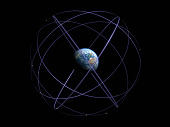Hybrid Propagation

Orbit propagation of satellites around the Earth plays an important role in managing the space environment. Modern propagation models take into account perturbations due to the Earth's oblateness, aerodynamic drag, and third body perturbations from the Sun and the Moon. While some of these, such as the Earth's oblateness, are well understood and measured, other effects are difficult to model accurately. In particular, the aerodynamic drag is a challenging problem, as it depends both on a constantly changing environment (atmospheric density) as well as the attitude and shape of the satellite. This leads to large errors in situations where the dynamics are dominated by those effects.
High fidelity models are computationally intensive as they require precise numerical integration. Analytical solutions to the problem are not possible as the equations of motion are not integrable. Simplified models are used to derive analytical solutions. These solutions, while not as accurate as high-fidelity models, allow very fast propagation.
Project overview
This project, studied in collaboration with a team at the University of La Rioja (press release) and subject of an Ariadna call for propsal [1], will investigate the possibility of machine learning or time series data mining techniques to predict the error of analytical orbit propagators given previous observations.
Through the public NORAD catalog as well as ESA’s own data, observations of spacecraft states over time are available. Current propagation models typically take the last known observation as the initial state. The goal of this project is to make better use of this trove of data using modern data mining techniques such as statistical time series modelling, data mining and machine learning to improve the accuracy and efficiency of current orbit propagators.
Hybrid Propagators
Recently, hybrid propagation has been proposed as one method of combining historical observation data and low-fidelity analytical propagators [2]. It represents the trajectory as the sum of an analytical model (such as classical SGP4) and an error function representing the difference between the actual orbit and the analytical model. The error model is fitted using historical observation data.
The objective of this study is to use more advanced techniques for hybrid propagators to make these much more useful. This includes the effect of modelling the error function in different ways, such as a model-free approach based on machine learning as well as heuristic models of the error. The model-free approach learns the shape of the error using machine learning techniques, while the heuristic model uses classical time-series prediction methods combined with domain-specific knowledge to express the error function.
The accuracy and effectiveness of each error model implementation is evaluated in several different relevant orbital regimes for orbit propagation times between 1 and 60 days. Results will be compared against a high-fidelity numerical model as well as actual observations.
References:
[1] Ariadna study description (link)
[2] “Hybrid SGP4: First approach”. Dr. Juan Félix San-Juan, Scientific Computing Group (GRUCACI), University of La Rioja (KePassa 2015, Toulouse)